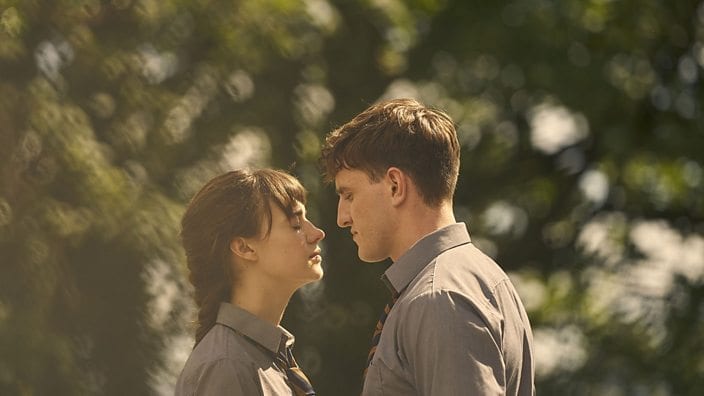The widely anticipated adaptation of Normal People has hit BBC iPlayer and Hulu. It still exposes the profound pain of first love, but is it really that … sexy?
In 2018 Sally Rooney generated somewhat of a Twilight effect for adults with her novel Normal People, and yet miraculously maintained literary approval, with The Guardian naming it one of the top 100 books of the 21st century. Televising the series was practically admitting defeat from the get-go – it would suffer from the book’s success. It would never satisfy every reader who claims ownership over Connell (Paul Mescal) and Marianne (Daisy Edgar-Jones), and the newcomers would always measure it against the bar of hype. Directors Lenny Abrahamson and Hettie McDonald were, and are, up against a positive tsunami of expectation.
They succeeded. Not necessarily in showing me the story I once saw in the book, but holding up their darker vision of the text. Following our protagonists from high school to university, the story is a simple one of boy meets girl. It captures a delicate yet monumental moment in one’s life when we try to shed the insecurities and immaturities of school, only to meet adulthood with a new plethora of struggles, revolving around the question: who are we?
In 2018, many fell in love with Rooney’s ability to capture characters through the silence of their gestures and mannerisms. For those worried that this might not translate well on screen, the screenplay – by Rooney herself – gently takes each word off the page and allows it to dissolve into pitch-perfect performances from Mescal and Edgar-Jones. We see Connell tasked with learning to be confident in his stereotypically contradictory identity: a rugby lad and a literary scholar. Mescal surpasses my mind’s eye of who Connell is and replaces him, frankly, with a better one. Without a narrator to infiltrate Connell’s shyness, there was a chance he would get lost on screen. Yet, Mescal perfectly captures Connell’s cowardly adolescent dedication to his reputation, his sensibility despite his own emotional ignorance, and his aversion to self-belief.
“Whilst Connell’s inner conflicts are subtly revealed in how he awkwardly manoeuvres through the world, the brooding shots of Marianne’s melancholy showers – a “lost girl”- became overkill.”
Edgar-Jones’ understated performance successfully shelters Marianne’s quirkier personality from cringeworthy cliché. But the series presents a far less dominant and eccentric character that many might’ve been expecting. For Marianne, teenage-hood’s undertaking is unlearning her “inherent coldness”, as a result of an abusive upbringing. Whilst Connell’s inner conflicts are subtly revealed in how he awkwardly manoeuvres through the world, the brooding shots of Marianne’s melancholy showers – a “lost girl”- became overkill. The simultaneously vulnerable-yet-self-assured Marianne that Rooney once wrote, who often overpowers Connell, here feels a shadow of the ‘broken’ Marianne. The production didn’t seem to know how to present – or really conceive of – this duality.
Read more: Book Review: Conversations With Friends
Whilst many have described their onscreen chemistry as ‘hot’ and ‘sexy’, I found the pair anything but. They came across as vulnerable and uncomfortable; the sex scenes at points were too awkward for viewing. But rather than labelling it a casting failure – how I would with Anne Hathaway and Jim Sturgess in the equally anticipated movie of One Day – their jarred screen presence made them even more captivating. Reading the novel I was able to project my own romantic gloss onto the characters; on screen I saw the them in a sobering light. They come across as two lost people who simply don’t know how to exist in the world, left to forcibly orbit one another. For many of us, our first love represents a place of safety that we gravitate towards like a broken record. The series holds a mirror up to this. Rather than a sexy ‘will-they-won’t-they’, each’s own turmoil essentially cockblocks a profoundly existential connection…for twelve episodes. We are shown how sex can become a substitute for failed communication. Yes, this paralysed communication teetered on tenuous – breaking up because he was too nervous to ask to stay at hers? Right. But, it did feel like a caustic tale for how detrimental the absence of vulnerability can be on the relationship itself, and instead, sex begins to imitate true intimacy.
“The series holds a mirror up to this. Rather than a sexy ‘will-they-won’t-they’, each’s own turmoil essentially cockblocks a profoundly existential connection…for twelve episodes.”
Perhaps the most noteworthy decision was to structure Normal People around twelve twenty-minute episodes, which worked both with and against the story. Artistically, the all-in-one effect of watching them back-to-back began to blur episodes together, detracting from the beats of the story (maybe just don’t binge it?). But the moreish nature of each vignette does match the intensity of first love: too intense to be revisited, misunderstood with perspective, and quite painful viewing. The at-times monotonous look at four years of their lives left me a sense of infuriated impatience at their on-and-off dynamic. How many distressed showers, or passive aggressive drives, do the pair need to either give it a chance, or call it off? I suppose this episodic effect is precisely the point: to reveal the borderline sadomasochism of certain modern relationships that are neither here nor there. In the words of RuPaul, Normal People practically screams at us: “If you don’t love yourself, how the hell you gonna love somebody else?”
Words by Niamh Rowe
